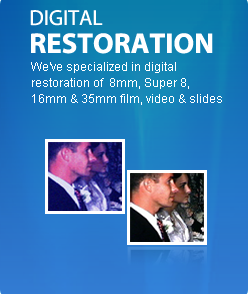
Film Conversion Equipment
Film Scanning and Film Transfer Equipment Types
The type of film scanning machine used for your 8mm, Super 8 or 16mm film conversion will have as much of an impact on the quality you receive as the resolution of the scan itself will. For example, if you wanted to digitize a photograph and tried doing it two different ways. You first put the photograph down on a table and took a picture of it using your smart phone or camera. Then you took the picture and scanned it using a flatbed scanner. If you compare the two side by side on your computer it will become really obvious that the flatbed scanner produced a digital image as good as the photograph. However, the picture you took with your phone or camera does not look close to the quality of the original photograph.
The same goes for scanning your 8mm, Super 8 or 16mm film. The real-time and frame by frame machines below are using a camcorder to take a picture of your film. The motion picture film scanner and Datacine machine are scanning the film. The results will be significantly different.
Film Conversion Equipment |
|
Real Time
|
|
Frame by Frame
|
|
Professional Film Scanners
|
|
The film transfer processes above are the basics types and do not include any restoration by themselves. Restoration comes in many different capabilities from color and exposure correction, to grain elimination, to stabilization
Joliet Fun Facts: Routes 6 and 52, and Illinois State Highways 53 and 171. Interstates I-55 and I-80 run nearby, intersecting just west of the city limits. Joliet is home to Joliet Junior College, the oldest public community college in the nation. Founded in 1673 by French-Canadian explorer Louis Joliet, the site of the present-day city of Joliet was not laid out as a town until 1834.
Illinois Fun Facts: After the American Revolution, Illinois became a territory of the United States, and achieved statehood in 1818. Located on Lake Michigan, and connected to the eastern ports via the Erie Canal, Chicago became a booming metropolis, and even the fire of 1871 could not stunt its growth. In the second half of the 19th century the great need for workers in the mills, rail yards and slaughterhouses made Chicago a popular destination for immigrants and freed blacks. During Prohibition Chicago became synonymous with bootleg liquor and gangsters like Al Capone.








